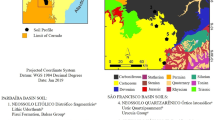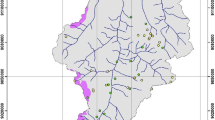Abstract
Rare earth elements (REEs) are widely used in industry and the entry of REEs into the pedosphere is assumed. Data about REEs in soils are scarce since only a few studies discuss their ecologically relevant behavior. Hence, we investigated total contents (aqua regia digestion) and potentially bioavailable contents (EDTA extraction) of REEs in soils from the Nidda catchment in Hesse (Central Germany). The study site covers a 1,600 km² sized area and 232 soil samples from 63 soil profiles were examined. The total REE content varied considerably, ranging from 544 mg kg−1 to 41 mg kg−1 (mean 201.1 mg kg−1) with a high proportion of light REEs. Highest REE contents were found in the soilscape VB, followed by LVB, WNE, T, WSW and BF with the smallest concentrations. With respect to the parent material the contents decreased in the following order: basalt > clay slate > loess > sandstone. On average 15.9% of the total REEs belong to the potentially bioavailable fraction. They range greatly by a factor of 100, between 1.3 and 171.3 mg kg−1 (average 33.5 mg kg−1). Remarkably, Yttrium has a maximum available proportion of 75%. In contrast, Ce showed the highest total contents with the smallest potentially bioavailable proportion of all elements. Regression analyses established relation between soil properties and the potential bioavailability of REEs. Around 53% (range from 29.9 to 76.8%) of the REE’s potential bioavailability variations could be explained by the chosen variables (pH, clay and Corg contents and the total element concentrations). Occurrence patterns and concentrations of REEs lie within the range of the results found in the available literature. Bioavailability is linked to soil properties and varies greatly according to the individual element. In comparison with the chosen soil properties the pH value shows the least impact on bioavailability.




Similar content being viewed by others
Abbreviations
- AAS:
-
Atomic absorption spectrometer
- BF:
-
Buedingen Forest
- ICP-OES:
-
Inductively coupled plasma-optical emission spectrometry
- LVB:
-
Lower Vogelsberg
- REE(s):
-
Rare earth element(s)
- T:
-
Taunus
- VB:
-
Vogelsberg
- WNE:
-
Wetterau northeast
- WSW:
-
Wetterau southwest
References
Aide M, Smith-Aide C (2003) Assessing soil genesis by rare-earth elemental analysis. Soil Sci Soc Am J 67:1470–1476
Aubert D, Probst A, Stille P (2004) Distribution and origin of major and trace elements (particularly REE, U and Th) into labile and residual phases in an acid soil profile (Vosges Mountains, France). Appl Geochem 19:899–916
Behrens T, Schmidt K, Gerber R, Albrecht C, Felix-Henningsen P, Scholten T (2008) Shortest representative transects for linear operated proximal soil sensing surveys. In: Viscarra-Rossel et al.: Proc. 1st Global Workshop on High Resolution Digital Soil Sensing and Mapping. Sydney, Australia
Bermond A, Yousfi I, Ghestem J-P (1998) Kinetic approach to the chemical speciation of trace metals in soils. Analyst 123:785–789
AG Boden (2005) Bodenkundliche Kartieranleitung. Schweizerbart’sche, Stuttgart
Cao X, Chen Y, Wang X, Deng X (2001) Effects of redox potential and pH value on the release of rare earth elements from soil. Chemosphere 44:655–661
Chandrajith R, Dissanayake CB, Tobschall HJ (2008) Abundance of rare earth elements in rice paddy soils from three regions of Sri Lanka. Paddy Water Environ 2:163–169
Diatloff E, Asher CJ, Smith FW (1996) Concentration of rare earth elements in some Australian soils. Aust J Soil Res 34:735–747
DIN 18129 (1996) Soil, investigation and testing—Determination of lime content. DIN Deutsches Institut für Normung e.V, Beuth
DIN 32645 (2008) Chemical analysis—Decision limit, detection limit and determination limit under repeatability conditions—Terms, methods, evaluation. DIN Deutsches Institut für Normung e.V, Beuth
DIN ISO 10390 (2005) Soil quality—determination of pH. DIN Deutsches Institut für Normung e.V, Beuth
DIN ISO 11277 (2002) Soil quality—determination of particle size distribution in mineral soil material—method by sieving and sedimentation. DIN Deutsches Institut für Normung e.V, Beuth
DIN ISO 11466 (1997) Soil quality—extraction of trace elements soluble in aqua regia. DIN Deutsches Institut für Normung e.V, Beuth
Fang J, Wen B, Xiao-Quan S, Huan-hua W, Jin-ming L, Shu-zhen Z (2007) Evaluation of bioavailability of light rare earth elements to wheat (Triticum aestivum L.) under field conditions. Geoderma 141:53–59
FAO (2006) Guidelines for soil description. Food and Agriculture Organization of the United Nations, Rome
Fu F, Akagi T, Yabuki S, Iwaki M (2001) The variation of REE (rare earth elements) patterns in soil-grown plants: a new proxy for the source of rare earth elements and silicon in plants. Plant Soil 235:53–64
Haxel GB, Hedrick JB, Orris GJ (2002) Rare earth elements—critical resources for high technology. USGS Fact Sheet 087–02. U.S. Geological Survey, Washington
He ML, Ranz D, Rambeck WA (2001) Study on the performance enhancing effect of rare earth elements in growing and fattening pigs. J Anim Physiol An N 85:263–270
Henderson P (1984) Rare earth element geochemistry. Developments in geochemistry, vol. 2. Elsevier, Amsterdam
HLUG (Hessian Sate Office for Environment and Geology) (2002) Bodenflächendaten von Hessen 1:50.000 (BFD 50). Kartenblätter L5516,L 5518, L5520, L5716, L5718, L5720, L5918 Wiesbaden
Hu Z, Richter H, Sparovek G, Schnug E (2004) Physiological and biochemical effects of rare earth elements on plants and their agricultural significance: a review. J Plant Nutr 27:183–220
Hu Z, Haneklaus S, Sparovek G, Schnug E (2006) Rare earth elements in soils. Commun Soil Sci Plan 37:1381–1420
Jifeng G (1998) REE geochemistry of some metamorphic rock types of the late Archean Fuping group and their Anatectic derivatives in Pingshan, Hebei Province, China—a preliminary study. Chin J Geochem 17:49–57
Kimoto A, Nearing MA, Shipitalo MJ, Polyakov VO (2006) Multi-year tracking of sediment sources in a small agricultural watershed using rare earth elements. Earth Surf Proc Land 31:1763–1774
Klausing O (1988) Die Naturräume Hessens mit einer Karte der naturräumlichen Gliederung 1:200.000. Schriftenreihe der Hessischen Landesanstalt für Umwelt, 67, Wiesbaden
Laveuf C, Cornu S (2009) A review on the potentially of rare earth elements to trace pedogenetic processes. Geoderma 154:1–12
Laveuf C, Cornu S, Juillot F (2008) Rare earth elements as tracers of pedogenetic processes. CR Geosci 340:523–532
Li C, Kang S, Wang X, Ajmone-Marsan F, Zhang Q (2008) Heavy metals and rare earth elements (REEs) in soil from the Nam Co Basin, Tibetan Plateau. Environ Geol 53:1433–1440
Liang T, Zhang S, Wang L, Kung H-T, Wang Y, Hu A, Ding S (2005) Environmental biogeochemical behaviors of rare earth elements in soil-plant systems. Environ Geochem Hlth 27:301–311
Loell M, Reiher W, Felix-Henningsen P (2011) Contents and bioavailability of rare earth elements in agricultural soils in Hesse (Germany). J Plant Nutr Soil Sc. doi:10.1002/jpln.201000265
Ma Y-J, Huo R-K, Liu C-Q (2002) Speciation and fractionation of rare earth elements in a lateric profile from southern China: identification of the carriers of Ce anomalies. Proceedings of the Goldschmidt Conference, Davos, Switzerland
Mao LJ, Mo DW, Yang J-H, Shi CX (2009) Geochemistry of trace and rare earth elements in red soils from the dongting lake area and its environmental significance. Pedosphere 19:615–622
Miao L, Xu R, Xu J (2007) Geochemical characteristics of Rare Earth Elements (REEs) in the soil-plant system in West Guangdong Province. Acta Pedologica Sinica 44:54–62
DWD (Germany’s National Meteorological Service, Deutscher Wetterdienst) (2004) Climatological Data from weather stations
Pang X, Li D, Peng A (2002) Application of rare-earth elements in the agriculture of China and its environmental behaviour in soil. Environ Sci Pollut R 9:143–148
Saile T (1998) Untersuchungen zur ur- und frühgeschichtlichen Besiedlung der nördlichen Wetterau. Materialien zur Vor- und Frühgeschichte von Hessen 21. Wiesbaden
Schmidt K, Behrens T, Friedrich K, Scholten T (2010) A method to generate soilscapes from soil maps. J Plant Nutr Soil Sc 173:163–172
Schwabe A, Meyer U, Flachowsky G, Dänicke S (2011) Effect of graded levels of rare earth elements in diets of fattening bulls on growing and slaughtering performance, and on nutrient digestibility of wethers. Arch Tierernahr 65:55–73
Tyler G (2004) Rare earth elements in soil and plant systems—a review. Plant Soil 276:191–206
Tyler G, Olsson T (2001) Plant uptake of major and minor mineral elements as influenced by soil acidity and liming. Plant Soil 230:307–321
U.S. Geological Survey (2011) Mineral commodity summaries 2011. U.S. Geological Survey, Washington
Ure AM, Quevauviller PH, Muntaus H, Griebpink B (1993) Speciation of heavy metals in soils and sediments. An account of the improvement and harmonization of extraction techniques undertaken under the auspices of the BCR of the Commission of the European Communities. Int J Environ An Ch 51:135–151
Wyttenbach A, Tobler L, Furrer V (1996) The concentration of rare earth elements in plants and in the adjacent soils. J Radioanal Nucl Ch 204:401–423
Wyttenbach A, Furrer V, Schleppi P, Tobler L (1998) Rare earth elements in soil and in soil-grown plants. Plant Soil 199:267–273
Xu X, Zhu W, Wang Z, Witkamp G-J (2003) Accumulation of rare earth elements in maize plants (Zea mays L.) after application of mixtures of rare earth elements and lanthanum. Plant Soil 252:267–277
Yamasaki S, Takeda A, Nanzyo M, Taniyama I, Nakai M (2001) Background levels of trace and ultra-trace elements in soils of Japan. Soil Sci Plant Nutr 47:755–765
Yang T, Zhu Z, Gao Q, Rao Z, Han J, Wu Y (2010) Trace element geochemistry in topsoil from East China. Environ Earth Sci 60:623–631
Yong R, Zheng L (1999) Contents and distribution of rare earth elements in main types of soils in China. J Rare Earth 17:213–217
Yufeng Z, Zhenghua W, Xiarong W, Lemei D, Yijun C (2001) Mobility of the rare earth elements with acid rainwater leaching in the soil column. B Environ Contam Tox 67:399–407
Zhang S, Shan X-Q, Li F (2000) Low-molecular-weight-organic-acids as extractant to predict plant bioavailability of rare earth elements. Int J Environ An Ch 76:283–294
Acknowledgements
The authors thank the technical staff and students of the Institute of Soil Science and Soil Conservation at the Justus-Liebig University Giessen for their work in the field and the preparation of the samples. We thank Simon Berkowicz for English corrections, Dr. Manfred Hollenhorst for helpful discussions on statistical issues and two anonymous reviewers for their helpful comments.
Mareike Loell is especially grateful to Elke Schneidenwind and Sezin Oeztan, not only for their support in the lab, but for many good hours of working and—at the right time—laughing together.
Author information
Authors and Affiliations
Corresponding author
Additional information
Responsible Editor: Robert Reid.
Rights and permissions
About this article
Cite this article
Loell, M., Albrecht, C. & Felix-Henningsen, P. Rare earth elements and relation between their potential bioavailability and soil properties, Nidda catchment (Central Germany). Plant Soil 349, 303–317 (2011). https://doi.org/10.1007/s11104-011-0875-y
Received:
Accepted:
Published:
Issue Date:
DOI: https://doi.org/10.1007/s11104-011-0875-y




